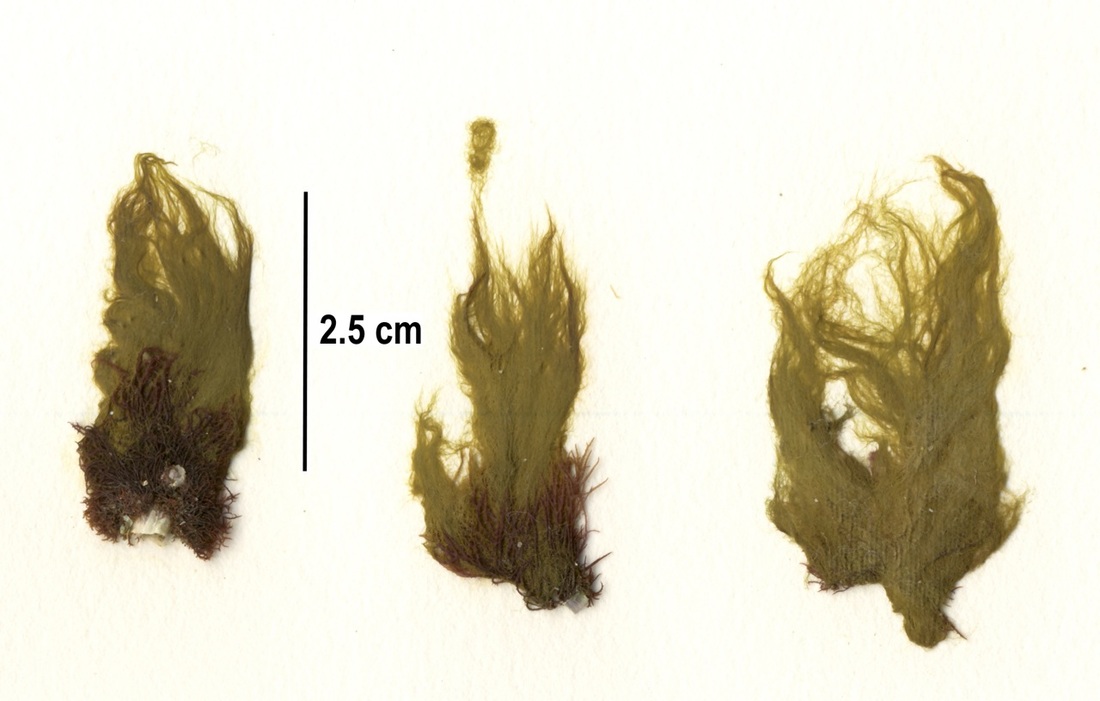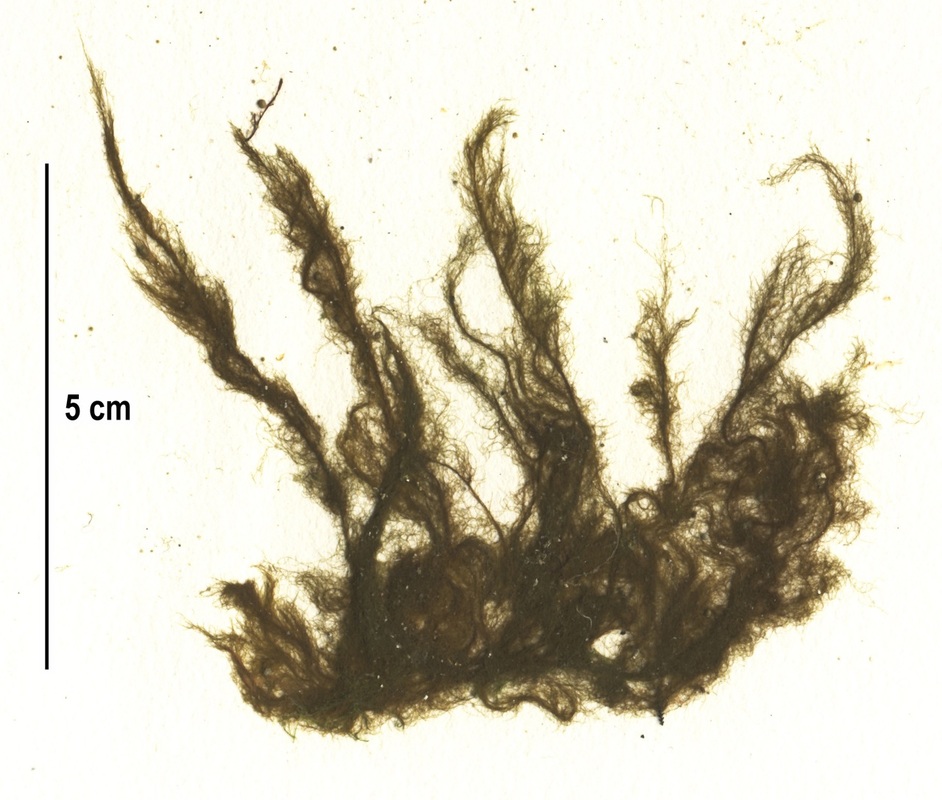Sea felt • Pylaiella littoralis
Specimen collection numbers SCL 15367 and PTM 463 in the UBC Herbarium Algae Database. Search the collection number in the database for more information on these specimens, or search the species for further occurrences. Images courtesy of Sandra Lindstrom.
Identification
The thallus of this brown seaweed consists of many fine filaments, giving the species the appearance of dense matted hair when out of water and a fluffy appearance in water. These filaments are highly branched, usually in an opposite branching pattern, and grow to 5 cm long. A microscope is necessary to see the branching pattern, as well as small swellings scattered along the filaments: these swellings are reproductive cells, and their placement along filaments rather than at filament tips is characteristic of Pylaiella species. Sea felt varies in colour from yellow to dark brown.
Habitat & Range
Sea felt grows on rock, epiphytically on other algae, and forms free-floating mats. It commonly grows on rockweed (Fucus distichus). It can be found in the mid intertidal on protected shorelines and in estuaries, from the Bering Sea and Aleutian Islands to southern California. Its range also extends into the Arctic Ocean, and west to Russia, Japan, and Korea. Its presence is also reported in the North Atlantic and along the coasts of Chile and southern Australia.
Similar Species
Similar genera include Ectopcarpus (such as E. commensalis), Elachista, and Sphacelaria. As noted above, species of Pylaiella differ from other genera in the location of their reproductive cells (sporangia and gametangia). Within Pylaiella species differences are not well defined; the features that distinguish P. littoralis as describedin the key by Gabrielson et al. are its highly branched nature and its opposite (or occasionally alternate) branch pattern.
iNaturalist
https://www.inaturalist.org/taxa/202295-Pylaiella-littoralis
The thallus of this brown seaweed consists of many fine filaments, giving the species the appearance of dense matted hair when out of water and a fluffy appearance in water. These filaments are highly branched, usually in an opposite branching pattern, and grow to 5 cm long. A microscope is necessary to see the branching pattern, as well as small swellings scattered along the filaments: these swellings are reproductive cells, and their placement along filaments rather than at filament tips is characteristic of Pylaiella species. Sea felt varies in colour from yellow to dark brown.
Habitat & Range
Sea felt grows on rock, epiphytically on other algae, and forms free-floating mats. It commonly grows on rockweed (Fucus distichus). It can be found in the mid intertidal on protected shorelines and in estuaries, from the Bering Sea and Aleutian Islands to southern California. Its range also extends into the Arctic Ocean, and west to Russia, Japan, and Korea. Its presence is also reported in the North Atlantic and along the coasts of Chile and southern Australia.
Similar Species
Similar genera include Ectopcarpus (such as E. commensalis), Elachista, and Sphacelaria. As noted above, species of Pylaiella differ from other genera in the location of their reproductive cells (sporangia and gametangia). Within Pylaiella species differences are not well defined; the features that distinguish P. littoralis as describedin the key by Gabrielson et al. are its highly branched nature and its opposite (or occasionally alternate) branch pattern.
iNaturalist
https://www.inaturalist.org/taxa/202295-Pylaiella-littoralis
References
Gabrielson, Paul W., Thomas Benjamin Widdowson, and Sandra C. Lindstrom. Keys to the seaweeds and seagrasses of southeast Alaska, British Columbia, Washington, and Oregon. No. 8. University of British Columbia, 2012.
Lindberg, M. and Lindstrom, S. (2010). Pylaiella littoralis Sea Felt. Seaweeds of Alaska. Accessed 12/04/2016.
O'Clair, R. and Lindstrom, S. Pylaiella littoralis (Linnaeus) Kjellman. In Klinkenberg, Brian. (Ed.). E-Flora BC: Electronic Atlas of the Plants of British Columbia. Lab for Advanced Spatial Analysis, Department of Geography, University of British Columbia, Vancouver. Accessed 12/04/2016.
Authors and Editors of Page
Kelly Fretwell (2016).
Gabrielson, Paul W., Thomas Benjamin Widdowson, and Sandra C. Lindstrom. Keys to the seaweeds and seagrasses of southeast Alaska, British Columbia, Washington, and Oregon. No. 8. University of British Columbia, 2012.
Lindberg, M. and Lindstrom, S. (2010). Pylaiella littoralis Sea Felt. Seaweeds of Alaska. Accessed 12/04/2016.
O'Clair, R. and Lindstrom, S. Pylaiella littoralis (Linnaeus) Kjellman. In Klinkenberg, Brian. (Ed.). E-Flora BC: Electronic Atlas of the Plants of British Columbia. Lab for Advanced Spatial Analysis, Department of Geography, University of British Columbia, Vancouver. Accessed 12/04/2016.
Authors and Editors of Page
Kelly Fretwell (2016).






